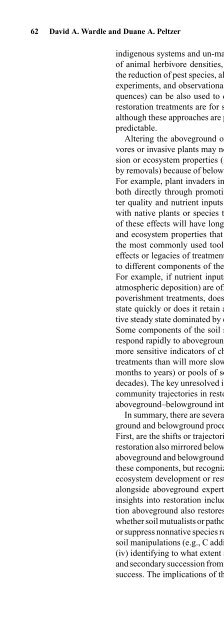Linking Restoration and Ecological Succession (Springer ... - Inecol
Linking Restoration and Ecological Succession (Springer ... - Inecol
Linking Restoration and Ecological Succession (Springer ... - Inecol
You also want an ePaper? Increase the reach of your titles
YUMPU automatically turns print PDFs into web optimized ePapers that Google loves.
62 David A. Wardle <strong>and</strong> Duane A. Peltzer<br />
indigenous systems <strong>and</strong> un-manipulated systems. Similarly, do manipulations<br />
of animal herbivore densities, either through restoration of native species or<br />
the reduction of pest species, also restore soil communities? Models, long-term<br />
experiments, <strong>and</strong> observational studies (such as across well defined chronosequences)<br />
can be also used to determine what the long-term consequences of<br />
restoration treatments are for successional processes or ecosystem properties,<br />
although these approaches are probably most useful for systems that are highly<br />
predictable.<br />
Altering the aboveground or belowground community by removing herbivores<br />
or invasive plants may not always produce the desired result for succession<br />
or ecosystem properties (i.e., their impacts are not immediately reversed<br />
by removals) because of belowground legacies that may persist for a long time.<br />
For example, plant invaders interact strongly with belowground communities<br />
both directly through promoting NPP (higher C inputs), <strong>and</strong> influencing litter<br />
quality <strong>and</strong> nutrient inputs to the soil; <strong>and</strong> indirectly through interactions<br />
with native plants or species that show different plant–soil feedbacks. Many<br />
of these effects will have long-term implications for successional trajectories<br />
<strong>and</strong> ecosystem properties that cannot be mitigated by the removal of weeds,<br />
the most commonly used tool in restoration efforts. In addition to persistent<br />
effects or legacies of treatments, there will also be important lags in response<br />
to different components of the soil subsystem to aboveground manipulations.<br />
For example, if nutrient inputs into a system (e.g., from a N-fixing weed or<br />
atmospheric deposition) are offset by reducing these inputs or through soil impoverishment<br />
treatments, does the belowground system return to its previous<br />
state quickly or does it retain accumulated nutrients <strong>and</strong> switch to an alternative<br />
steady state dominated by early successional, nutrient-dem<strong>and</strong>ing species?<br />
Some components of the soil subsystem, such as the microbial biomass, will<br />
respond rapidly to aboveground treatments (i.e., weeks to months) <strong>and</strong> will be<br />
more sensitive indicators of changes in belowground processes to restoration<br />
treatments than will more slowly responding soil meso- <strong>and</strong> macrofauna (i.e.,<br />
months to years) or pools of soil organic matter <strong>and</strong> nutrients (i.e., months to<br />
decades). The key unresolved issue is which long-term ecosystem properties or<br />
community trajectories in restoration are predictable from short-term shifts in<br />
aboveground–belowground interactions.<br />
In summary, there are several critical areas for future research linking aboveground<br />
<strong>and</strong> belowground processes in succession to underst<strong>and</strong>ing restoration.<br />
First, are the shifts or trajectories in aboveground communities manipulated in<br />
restoration also mirrored belowground? Current studies document shifts in both<br />
aboveground <strong>and</strong> belowground communities, <strong>and</strong> clearly point to links between<br />
these components, but recognizing the importance of these links to succession,<br />
ecosystem development or restoration requires the inclusion of soil biologists<br />
alongside aboveground expertise. Examples of research that should provide<br />
insights into restoration include: (i) determining whether successful restoration<br />
aboveground also restores belowground communities, (ii) underst<strong>and</strong>ing<br />
whether soil mutualists or pathogens can be used to either promote native species<br />
or suppress nonnative species respectively, (iii) underst<strong>and</strong>ing in what situations<br />
soil manipulations (e.g., C additions) help or hinder ecosystem restoration, <strong>and</strong><br />
(iv) identifying to what extent shifts in belowground processes during primary<br />
<strong>and</strong> secondary succession from field studies can be used to determine restoration<br />
success. The implications of these topics for restoration are obvious: soils <strong>and</strong>

















